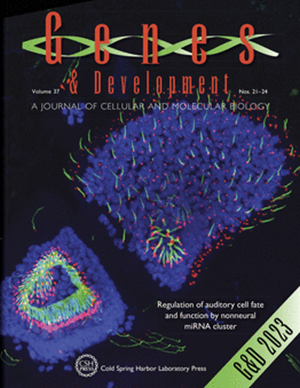rDNA重复序列远端连接处的LINE1元件调节人胚胎干细胞的核仁组织
IF 7.7
1区 生物学
Q1 CELL BIOLOGY
引用次数: 0
摘要
核核是核糖体DNA (rDNA)转录和核糖体组装的主要亚核区室。此外,最近的研究表明,核仁是染色质结构的动态组织者,调节发育基因的表达。rDNA基因单元被组装成位于5条人类顶心染色体p臂上的阵列。远端连接(dj)是与rDNA阵列相邻的约400kb的序列,被认为将它们锚定在核核上,尽管潜在的调控元件尚不清楚。在这里,我们展示了dj在人类胚胎干细胞(hESCs)中表现出动态的染色体构象。我们在所有人类dj的保守位置发现了一个灵长类特有的、全长插入的反转录转座子long interspersed nuclear element 1 (LINE1)。这个DJ- line1位点与DJ的特定区域相互作用,并在naïve hESCs中上调。基于crispr的缺失和干扰方法显示,DJ-LINE1参与dj的核仁定位。此外,我们发现DJ-LINE1的表达对于维持hESCs核仁的结构和转录输出是必需的。在naïve hESCs中,DJ-LINE1的沉默导致自我更新的丧失、染色质可及性的破坏以及早期发育程序的抑制。这项工作揭示了在hESCs核仁组织中具有基本作用的特定LINE1元件,并为核仁作为关键的基因组组织中心如何发挥作用提供了新的见解。本文章由计算机程序翻译,如有差异,请以英文原文为准。
LINE1 elements at distal junctions of rDNA repeats regulate nucleolar organization in human embryonic stem cells
The nucleolus is a major subnuclear compartment where ribosomal DNA (rDNA) is transcribed and ribosomes are assembled. In addition, recent studies have shown that the nucleolus is a dynamic organizer of chromatin architecture that modulates developmental gene expression. rDNA gene units are assembled into arrays located in the p-arms of five human acrocentric chromosomes. Distal junctions (DJs) are ∼400 kb sequences adjacent to rDNA arrays that are thought to anchor them at the nucleolus, although the underlying regulatory elements remain unclear. Here we show that DJs display a dynamic chromosome conformation profile in human embryonic stem cells (hESCs). We identified a primate-specific, full-length insertion of the retrotransposon long interspersed nuclear element 1 (LINE1) in a conserved position across all human DJs. This DJ-LINE1 locus interacts with specific regions of the DJ and is upregulated in naïve hESCs. CRISPR-based deletion and interference approaches revealed that DJ-LINE1 contributes to nucleolar positioning of the DJs. Moreover, we found that the expression of DJ-LINE1 is required for maintenance of the structure and transcriptional output of the nucleolus in hESCs. Silencing of DJ-LINE1 leads to loss of self-renewal, disruption of the landscape of chromatin accessibility, and derepression of earlier developmental programs in naïve hESCs. This work uncovers specific LINE1 elements with a fundamental role in nucleolar organization in hESCs and provides new insights into how the nucleolus functions as a key genome-organizing hub.
求助全文
通过发布文献求助,成功后即可免费获取论文全文。
去求助
来源期刊

Genes & development
生物-发育生物学
CiteScore
17.50
自引率
1.90%
发文量
71
审稿时长
3-6 weeks
期刊介绍:
Genes & Development is a research journal published in association with The Genetics Society. It publishes high-quality research papers in the areas of molecular biology, molecular genetics, and related fields. The journal features various research formats including Research papers, short Research Communications, and Resource/Methodology papers.
Genes & Development has gained recognition and is considered as one of the Top Five Research Journals in the field of Molecular Biology and Genetics. It has an impressive Impact Factor of 12.89. The journal is ranked #2 among Developmental Biology research journals, #5 in Genetics and Heredity, and is among the Top 20 in Cell Biology (according to ISI Journal Citation Reports®, 2021).
 求助内容:
求助内容: 应助结果提醒方式:
应助结果提醒方式:


